|
Ozark Green Thumb BCMG Monthly e-Newsletter |
|
|
|
GARDEN CHECKLIST
County Extension Agent University of Arkansas - Division of Agriculture Telephone: 425-2335
0 Comments
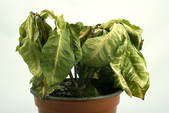 Disease is a general term that can include fungal, bacterial and viral pathogens. All three of these pathogens can lay dormant until favorable conditions present themselves. This can be related to temperature, moisture or plant health. Many of the diseases we encounter in the South favor hot and humid conditions. It is important to identify whether you are dealing with fungal, bacterial or viral pathogens. The control for each of these is completely different. This a list of potential disease problems you may encounter in your garden. 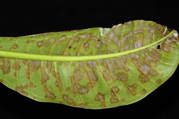 POWDERY MILDEW This disease can attack everything from trees and shrubs to vegetables. It appears as a gray-like powder on the tops of leaves. It is one of the only fungal disease problems that favors dry weather. It is most common in late spring and early fall. Powdery mildew can be controlled by spraying approved fungicides at 10 to 14 day intervals. 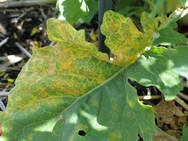 FUSARIUM WILT This another fungal pathogen that attacks a broad range of plants, including ornamentals and vegetables. This fungus occurs in the soil and penetrates the roots of the plant, working its way into the vascular system. It begins to clog up the plants "plumbing" causing leaves to turn yellow and stems to wilt. Treatment is very difficult once the plant is infected. Vegetable plants normally will die and need to be removed. 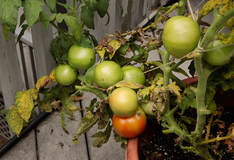 SEPTORIA LEAF SPOT AND SPOT ANTHRACNOSE These are two very common diseases that can be caused by either bacterial or fungal pathogens. Correct identification will be needed when selecting a control. Many times affected leaves can simply be plucked off and discarded. On larger shrubs and trees, the disease tends to be more of a cosmetic issue and the plant can normally survive.  BACTERIAL WILT Bacterial wilts are caused by several different strands of bacteria and can affect vegetables, flowers, and other herbaceous plants. This disease can be transmitted through infected soil or through insects feeding on infected plants and transmitting to healthy plants. Bacteria cause a disruption in the vascular system of plants causing them to discolor, wilt, and eventually die. Once bacteria enter into the plant, it is almost impossible to control. Discard infected plants and keep damaging insects under control to help with the spread of disease. Fumigation or solarization of the soil my be an effective way to control the disease for future crops.  FIRE BLIGHT This disease is actually a bacterium that is very host specific and affects members of the rose family. This includes pears, apples, crabapples, hawthorn, and Pyracantha. The disease is fed by insects feeding on the plants and is most active in late spring during warm, humid weather. Infected branches wilt and turn brown and then black as if scorched by fire. Spraying for this disease can be tricky depending upon the height of the plant or tree. Once infected, prune the damaged branches down several inches into the good wood. Remove the cut branches from the site. VIRUSES There are many viruses that can affect anything from ornamentals to fruit trees and vegetables. Viruses normally cause discoloration or mottling of leaves. Leaves and branches are often deformed and twisted and leaves may appear elongated or tiny. Insects, soil or moisture can carry or spread viruses. There are no effective controls so cutting damaged areas out and plant removal are the only remedies. DAMPING OFF This disease is caused by several species of fungi and is common in our Southern soils. It is one of the main causes of poor germination of vegetables and annual flowers. Seedlings are very susceptible when they first emerge. This disease is most prevalent in high-nitrogen soils that stay consistently wet. Plant seeds in well-amended and well-drained sites to minimize the chance of infection. Do not add high-nitrogen fertilizers until seedlings have grown several sets of leaves. Fungicide-coated seed can also discourage damping -off.  PHYTOPHTHORA AND PYTHIUM ROOT ROT Both of these fungi thrive in wet, poorly drained soils. They can attack the roots and stems of plants causing them to rot and eventually die. Gardeners frequently mistake the wilting for drought stress. Often individual plant branches die first and then the overall plant turns yellow and eventually dies. Prevent this disease by planting only in well drained areas. Water plants only when necessary and allow soil to dry out between irrigations. This short list of disease problems are only a handful of what is actually out there, but these are definitely some of the most common ones you may encounter. Careful plant selection and good cultural practices will go along way toward keeping your plants healthy and avoiding these potential killers. Excert from
"THE BEATEN PATHOGEN" By Bob Westerfield Arkansas Gardener October 2015 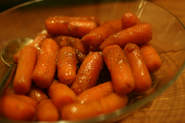 This is a tasty and easy to make side dish. Ingredients
Instructions 1. In a medium saucepan, combine the vinegar and
cornstarch; mix until cornstarch is dissolved. 2. Add the brown sugar and butter. Bring to a boil over medium heat, stirring until thickened. 3. Add the carrots and cook for 3 to 5 minutes, or until heated through. Serve immediately. Serves: 4  Fall has arrived and it is time to think about spring. Much of the beauty of the spring garden derives from the bulbs gardeners plant in the fall. The word "bulb" is used as a general term by gardeners for any of the flowers planted at this season even though some might be corms (crocus), tubers (anemones) or tuberous roots (ranunculus). But, come spring, the most spectacular flowers are produced by the true bulbs. To the botanist a bulb is an underground storage organ with a vertical stem axis surrounded by swollen leaf bases. The botanical term geophyte is used to describe all the storage types - bulbs, corms, tubers, rhizomes, etc - that gardeners collectively call "bulbs." True bulbs are found only among the monocotyledonous species; those plants with one seed leaf at germination. Most of the true bulbs are found in two plant families - the lily family or the amaryllis family - although many botanists are now breaking these old classification categories into many subsets at the family level. The bulbous habit of growth occurs almost exclusively in temperate parts of the world beyond 30 degrees north and south latitude. The geophytic lifestyle developed as a protection mechanism to allow plants to get through hard times, especially drought and cold. Most bulbous species are native to either grassland habitats or mountainous regions. In grasslands, bulbs are usually spring-blooming, with foliage dying down by early summer when the grasses suck all of the available water from the soil. In mountainous areas the bulbs flower quickly during spring, mature their foliage during the short summer and then disappear below ground during the long, cold winter. Bulbs have all the parts and pieces of an oak tree but they have gotten rid of all the superfluous stuff, leaving behind just a dormant bud. The stem of a bulb grows vertically, just like our oak tree, but it is only a few millimeters long. Called the "basal plate," it has nodes where leaves and new branches are produced and, at the end of the stem, a flower is formed. At the base of the stem, roots form just like a normal oak tree. The accompanying photo shows a cross-sectional view of a tulip, a hyacinth and a daffodil bulb. These species are what we call "tunicate" species, with the leaf bases enclosed in a papery covering. Lilies have "non-tunicate" bulbs, with the individual scales not encased in this protective sheath. Generally the tunicate species show more drought tolerance than the non-tunicate species. The three bulb species shown in the illustration above have three distinct means of maintaining the bulbous lifestyle. The tulip, native to the cold and dry steep regions of Central Asia, replaces its bulb each year after flowering. The food reserves of the original bulb are depleted to produce the stout stem, leaves, and flowers we so admire in April. If the climate is perfect - with cool conditions and just the right amount of moisture - the foliage will persist long enough to regenerate a big healthy bulb for the next season. But when, as in most gardens, conditions are not so good, the big bulb that was planted is replaced with a small bulb, and after two years it is too small to flower. A bulb too small to flower produces just a single leaf that splays out across the ground. Hyacinths, and in fact most other bulbs, retain their bulb from year to year and build on what they started with. If conditions are good the bulb will grow a bit larger; if not so good it will be a bit smaller. But it doesn't start over anew each year, so this lifestyle choice makes these kinds of bulbous plants more dependable repeat bloomers in the garden. Obviously, allowing the foliage to remain as long as possible helps ensure a bigger bulb for the coming season. The daffodil (Narcissus) shown is doing what oak trees do, branching. Some bulbs, like daffodils, branch freely while others, such as hyacinth, are slow to branch. In bulbs this characteristic is referred to as "producing offsets." Because daffodils branch freely it is not uncommon for a clump formed from a single bulb to become so crowded it stops flowering after 5 years or so. Digging, dividing and resetting the bulbs will allow the bulbs to grow large enough to flower. By: Gerald Klingaman, retired
Extension Horticulturist - Ornamentals Extension News - October 23, 2009 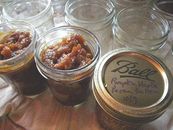 This is the easiest way to make pumpkin butter. Just let your slow cooker do all the work. INGREDIENTS
DIRECTIONS:
Set crockpot on low setting. Thoroughly combine the ingredients in the crock pot. Cover and cook for about five hours, stirring occasionally, until pumpkin butter is thick enough to stick to a spoon turned upside down. Spoon pumpkin butter into a jar and cool completely in the refrigerator before using. Pumpkin butter will keep in the refrigerator for up to one week or in the freezer for up to six months. 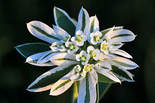 When I was walking my dog at Cooper Park recently, I saw this plant in front of the Shot Gun Cabin that I had never seen before. Of course I had to take a closer look. I thought it was lovely so I looked it up when I got home. It is native to Texas, New Mexico, Oklahoma, Missouri and Arkansas. "WILDFLOWERS-OF-TEXAS' by Dorothy Thetford COMMON NAME: Snow-on-the-Prairie BOTANICAL NAME: Euphorbia bicolor FAMILY: Euphorbiaceae Snow in September? On a prairie? In Texas? Sure....
Our native wildflower, commonly called snow-on-the-prairie Euphorbia bicolor, attracts attention to the hot, dry prairie with its cool, green and white bracts. These three to four-inch bracts are longer than the leaves of the plant, and completely dominate the tiny white flower structures. Actually, the white structure is not a flower, but a cyathium (the specialized inflorescence of Euphorbia, consisting of a flower-like, cup-shaped involucre which carries the several true flowers within) as defined by M. Enquist in his book WILDFLOWERS OF THE TEXAS HILL COUNTRY. Each 5-petaled structure, only 1/4 inch diameter, looks like it's been tucked into the base of the bracts as an afterthought, almost hidden by the long, wispy bracts. Snow-on-the prairie is a single, stout, hairy, 3 to 5-foot stem which splits, midway up the stem, into a perfect triangular set of (three) branches. With ample moisture, these three branches may grow 6 to 10 inches taller and split into additional sets of three branches. One to two-inch, hairy, lanceolate, alternate leaves line the stem up to the first branch split, and at that point, three opposite leaves encircle the base of the split. This interesting leaf arrangement is repeated with each new symmetrical branching. A milky latex weeps from any broken stem, leaf or bract. All Euphorbias contain this milky sap, which can cause dermatitis to sensitive-skinned persons, and, is toxic. Since livestock does not eat this plant, snow-on-the-prairie is normally found in very large colonies throughout the Grand Prairie, Blackland Prairie, east to east Texas, and from Montague County southwest to Johnson County. A single plant is intriguing, but a colony is breathtaking. As flowers mature, green, hairy, 3-seeded capsules develop and stay on the plant until they dry, harden, pop open and disperse seeds. This ballistic dispersal of seeds explains the scattered arrangement of plants on the prairie. If you plan to collect seeds from this annual, you must monitor the maturity and collect after the pod dries, but before it pops open. Texas Woman's University, under the direction of our Trinity Forks member, Camelia Maier, Ph.D., Associate Professor in the Biology Department, is currently researching E. bicolor to identify the chemical composition of estrogens within the plant for future medicinal purposes. Our sunny prairies and roadsides are extremely enticing with this grande native wildflower. While E. bicolor is in full bloom, take time to touch the leaves, and, use a magnifying lens to closely inspect the downy-soft, hairy details of this uniquely beautiful wildflower. I think you'll appreciate having snow-on-the-prairie, especially in Texas during the heat of August and September! 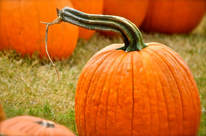 Latin: Cucurbita pep0 The pumpkin is as American as apple pie, yet its current status is a result of our diverse cultural heritage. The word pumpkin is derived from the middle English word "pumpion" which described a type of Old World melon. The pumpkins and squashes are thought to have originated in Central America and Mexico. They spread as Native Americans adopted them as a staple food over 9,000 years ago. Among the New England tribes these plants were described as "askutasquash." The Puritans of New England adopted "pumpion" for the large, orange-fruited vines and "squash" for all of the smaller-fruited edible sorts. Botanically speaking, pumpkins and squashes are kissing cousins belonging to the cucumber family. They are so closely related that pumpkins and some squashes will readily cross pollinate one another. If a non-pumpkin type pollinates a pumpkin flower, the resultant fruit will look like a normal pumpkin, but if seeds are saved and planted the next season, the fruit of the hybrid plant will be mongrelized. The acceptance of pumpkins by early colonists was not immediate. In fact, it took a good long New England winter to convince them that they were indeed tasty and nutritious. One of the earliest methods of preparing pumpkins was to cut a hole in the top, scoop out the seeds, and then fill the cavity with apples, molasses, spices and milk. The top was put back on and then the pumpkin was baked in a bed of coals. By the late 1700's, the standard method of preparing pumpkin, other than pumpkin bread, had become our standard pumpkin pie, which included eggs, molasses, allspice and ginger baked in a tart shell. The tradition of the jack o' lantern is interwoven with the traditions of the ancient Celts who celebrated a ceremony that apparently was part harvest ceremony and partly a ceremony to appease the spirits of the dead. This ritual included carrying lighted embers from ceremonial bonfires in carved out turnips -- a readily available ember-holder. Faces were carved on these turnips to scare off the spirits of the dead that came back to visit earth -- often in the form of black cats. In the 1750s, the old Irish folktale was written down, but changed to include a night watchman named Jack. The Irish potato famine a century later resulted in the immigration of over 600,000 Irish men and women to the United States. Finding few big turnips to carve, the pumpkin was adopted for Jack's lantern for the Christian All Hallows Eve festival. That holiday evolved into our nonsecular Halloween. Gardeners wishing to grow pumpkins need to first assess their goal. If the goal is to grow pumpkins for pies, one of the small fruited pie types such as Small Sugar or Jack-Be-Little are best. But if the goal is to grow a good carving pumpkin, say something in the 20 to 30 pound range, selections such as the old Connecticut Field or Jack o' Lantern are hard to beat. If the goal is to grow giant pumpkins for county bragging rights, Dill's Atlantic Giant, which occasionally will top 600 pounds, is for you. Pumpkins require 100 to 115 days to mature fruit and are usually planted after the soil warms in the spring from mid May until late June for jack-o-lanterns. By: Gerald Klingaman, retired
Extension Horticulturist - Ornamentals Extension News - October 30, 1998 Special Encore - October 24, 2008 |
Archives
April 2022
|
|
